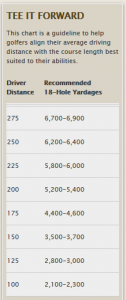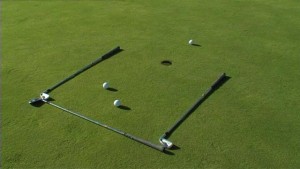One of the first goals of every golfer is to shoot an 18-hole score below 90 strokes, or “breaking 90” in golfing parlance. No matter the age, skill level, or experience, nearly every beginning golfer has the vision of breaking through and shooting a score in the elusive 80s.
As such, nearly every newcomer to the game has gone through the initial golf excitement and the frustration. Golfers probably know better than most to stay patient and keep grinding through whatever life (and golf) throws at them. No goal is achieved without laying out a plan of action. Writing down the goal of breaking 90, and the steps required to reach it, can help the mind focus on the and how to achieve it. Below are steps on how to break 90 in golf.
Choosing the Correct Tees
Choosing a realistic tee marker according to your ability is critical when chasing the breaking-90 dream. Unless you are playing in a competition, there is no rule stating that you cannot tee off from a combination of tees that fits your game. Tee markers are not based on whether you’re a female/male, senior/youth or championship level golfer.
It is based more off of driving distance than anything. Generally speaking, tour professionals and scratch players tee off at the farthest-back tee markers because they can hit the ball farther and more consistently. As players progress and lower their handicaps, they will move back from tee to tee to continually challenge their game.
A golf course usually has at least three sets of tee markers. On the scorecard, there are hole yardages, 9 and 18 hole total yardages, a course rating and sometimes a bogey rating. The course rating is a hypothetical score of what a scratch golfer would usually shoot from a respective tee that factors in normal weather and normal scoring conditions. If there is a bogey rating, a similar principle applies but it is what a bogey golfer would shoot from each set of tees. Before playing a course it would be a good idea to take a look at each rating and honestly assess your game.
The USGA has also started a new initiative called “Tee it Forward”. It addresses two issues that golfers are faced with when playing. The first is to address the issue of slow play and teeing it forward can help speed up play with fewer shots taken. The second is to align players with the correct set of tees for optimal scoring according to their driving distance.
A lot of players inflate their driving distance in their own mind after watching tour professionals on television each week thinking “I can hit it that far too”, when they can in fact not. Hitting the ball over 300 yards is not obtainable for most players and yet a lot of them still claim they can. Teeing it forward according to driving distance can create a more pleasurable experience and a reasonable chance of breaking 90!
Avoiding Penalty Shots
An easy way to save shots is to avoid penalty shots. However, it is easier said than done. According to GolfMadeSimple, 95 shooters will lose an average of three or more golf balls per round where 85 shooters will lose an average of two. A lot of times inexperienced golfers will break down and give up after losing one or two balls, especially coming down the stretch.
The never-give-up attitude is important when trying to break the threshold, especially if is something you really want. Even if you happen to lose one or two, 85 shooting golfers understand that there are some things that are uncontrollable in golf and should keep grinding and playing steady. There is no need to force things or “make things happen”. Practice will help minimize mistakes and make the bad shots better.
Avoiding 3 Putts
With the possible exception of hitting a ball out-of-bounds, and incurring the shot-plus-distance penalty that comes with it, there is nothing worse than taking three putts on the green, generally referred to as “3-putting”. Putting can be the easiest and most rewarding part of golf if you train your mind correctly. Having 3 putt eats away at a golfer’s patience and dents the mental confidence to hole a putt. Once on the green, two putts should be the maximum it will take to find the bottom of the cup. Putting can be broken into mental processes and the actual stroke itself.
Creating a solid, repeatable stroke under pressure is the result of many hours of practicing. A repeatable stroke is so key because it allows the player to focus on the hole as a target rather than worrying about his/her stroke. Once a player has a repeatable stroke, any putt is just figuring out the line and what speed it requires to hold the line.
Creating feel and touch for lag putting and solid strokes for putts within 5 feet will minimize 3 putting. Practicing putting can become monotonous so it is important to be creative to keep the mind focused and not “go through the motions”.
Practice Plan
Below are aspects to the game that every person wanting to break 90 should focus on in their practice. The areas that need to be improved for a 90 shooter targeting the 80s are driving consistency, 120 yards and in (scoring range) and putting. They are the most important factors when breaking 90 so most time practicing should be spent broken up between these areas of the game. The goal is to build a consistent foundation that is repeatable, especially under pressure. Testing yourself in practice simulating on-course scenarios is one of the best ways to practice. Get comfortable with being uncomfortable.
Driving Consistency
On the practice range, many players hit balls “going through the motions” and don’t apply any pressure on themselves. Continually slapping balls around the range will not improve any part of your game. It is an unrealistic scenario that never happens on the course. Hitting into a big field where no penalty occurs for an errant shot is not quality practice. Practice should only occur when mentally focused and creating artificial boundaries. This puts course-like pressure on you while testing the repeatability of the swing.
Finding a swing that will put the ball in play allows more attempts of finding the green in two, which in turn allows more putts for par or even birdie. Players don’t have to attack the ball like they’re in a long-drive contest every swing. A controlled, consistent swing that delivers solid strikes will often go farther than wild, hard swings at the ball. A drill that better players implement in their practice routine is to go through their full routine and set up imaginary boundaries before hitting a shot. Saying to yourself, “Left of that target is a water hazard and right of other target is OB”. You will find that in your routine you will stop trying to control every aspect of the swing and let it go.
The old phrase “practice like you play” is something 90 shooters should take to heart. If you want to break 90, practicing the same thing over and over again will most likely yield the same scores. When practicing it would benefit on-course results by going through your full routine every few shots. It will allow your mind to train like it is on the teebox out on the course.
120 Yards and in (Scoring Range)
While driving is important to get into the right position, all of the shots (including putting) from the yardage of 120 yards and in accounts for more than half of all shots taken during a round. Practice time should be spread out accordingly. Instead of beating drivers or long irons all day long, focus on wedge game and short game. If you can hit solid wedge shots with good rhythm than you can hit irons with the same quality. Figure out a distance that you are certain you can get on the green with and use that knowledge during the round! Par 5s you can lay up to that distance or if you happen to get stuck in the woods, punch out to that number.
A lot of golfers find that the “clock hand” system for hitting wedges provides a consistency for certain distances. The hand of a clock rotates around just like the arms of a player in the golf swing. A golfer addressing the ball would be at “six o’clock” because their hands are both freely hanging downward. A full swing, depending on the player and club, could be anywhere from 10 to 12 o’clock. An example of this would be hitting your 56-degree wedge from 70 yards. A player might find that turning and stopping their arms at “9 o’clock” provides a consistent strike for a ball to fly 70 yards. On the range it is an ideal place to figure out what it takes for each distance.
The short game area is including in the 120 yards and in practicing. Many 90 shooters find themselves short of the green and having to get up and down quite a bit. Having a solid pitching and chipping game can save a tremendous amount of shots. Professionals always proclaim that if they were going to knock off shots from their round it would be easiest to do it from the short game or putting area. Good chippers and pitchers will have better opportunities to make putts and decrease the chance of three putting.
Putting
One of the keys to breaking 90 is to eliminate 3 putting. Putting does not magically get better overnight; it takes time and practice. Players will go to a practice green and not know what or how to practice putting so they hit a few random putts hoping they go in. Being methodical in practice can free up putting out on the course.
Developing a repeatable routine, just like in the long game, can ease the mind when over a putt. The less time the routine takes the better (for the same reasons that it does in the long game – less tension in the body and mind).
Drills that can be done to improve putting should include more makeable putts (inside 10 feet) and lag putts. An example of a common short-putt drill is called the ladder drill or step drill. It has putts from 3, 6, and 9 feet at different “steps” or “rungs in the ladder”. To set up all you need are three tees, a relatively straight putt and a cup. The reason behind using a straight putt is to train your stroke to start the ball on line and repeat it.
Out on the course, after consistently starting it on line it is a matter of speed and reading the break correctly. After finding a straight putt place three tees to mark the spots of 3, 6, and 9 feet. The goal of the drill is to “climb up the ladder”. To start, place a ball at each 3, 6, and 9-foot distance and try to make them all consecutively by first making the 3 then 6 then 9-foot putt.
If you make the 3-footer but miss the 6-footer you start back at the 3-footer; the same rule applies if you miss the 9-footer. Once you complete one ball at each level continue on to two and three balls (same rules apply if you miss with the two and three balls at each step). To finish the drill, you should make three balls at each 3, 6, and 9 feet without missing a putt.
The box lag putting drill is a great use of time when practicing. It is very similar to the ladder drill but from length. Using tees or a few practice pins can be used to a create a box around the hole about 3 feet on each side. Then pace off 30, 60 and 90 feet to find consistency in your lag putting. Placing five balls from each distance and try to get them all into the zone consecutively before moving on to the next distance. Choosing both up and downhill putts can create feel and touch in the putting stroke for the speed of the greens at the course.
Course Management
Professionals have game plans out on the course. They don’t carry around a yardage book to look at a picture of the hole because they forgot if it was a dogleg left or a dogleg right. They use the books to pinpoint how far they need to hit a shot as well as strategize where they want to hit it or don’t want to hit it. Players consistently in the 90s usually go out on the course with minimal or no game plan at all. Golfers tend to hit whatever they feel like hitting without logically thinking about what the course is offering that day. Knowing your strengths and weaknesses can eliminate avoidable mistakes. An example of this would be laying up on a par 5 to your most comfortable distance.
A lot of people underestimate the importance of driving the golf ball when playing. Getting into position on a hole will set a player up for success. Out on the course, the driver isn’t always the best choice on certain holes. Pulling a three wood or iron off the tee is sometimes a better option and more rewarding, especially if it eliminates the threat of a hazard.
Mental Confidence
Breaking down a score of 89 is simple; it is 1 par and 17 bogeys! Every 90 shooter has made plenty of pars and bogeys in their golf career. If you think about it hard enough, you have probably parred every hole at your home club at one point or another. It is nothing unachievable because it is not something that has not been done before, just not during the same stretch of 18 holes. Piecing it all together through consistency and steadiness through a round is crucial.
Mentally approaching a round is different for everyone but many people get too tied up in a result rather than the process. Thinking about the process rather than the result of breaking 90 will free up people over shots. There are many rounds where professionals do not realize how low they are going because they focus on the process and add them up at the end. If 90 shooters developed this habit instead of thinking of what they are at after every hole it would change negative or anxious thoughts into positive and focused thoughts.
Developing a routine and focusing on sticking to it no matter what the game of golf throws at you can put your mind at rest. Are you more comfortable with something you’ve done a thousand times before or something you’ve never done? Your routine is that comfort! Routines should waste no time and should be nothing more than to relax the mind before entering the swing sequence. Too much time over the ball creates tension in the body and mind which can leads to poor shots. Many high handicappers take way too much time over the ball and start having bad thoughts about what might happen instead of focusing on the process and what they should be doing.
Shooting below 90 is a combination of factors. One day you may have two or more 3-putts but mentally not bothered by it and continue to grind. Every golfer is capable of shooting in the 80s but it might take some longer than others. Making pars, eliminating mistakes like 3-putts and avoiding hazards are all great but it comes down to doing it consistently. Having the confidence and mental approach needed is half of the battle; going out and doing it is the other half!





